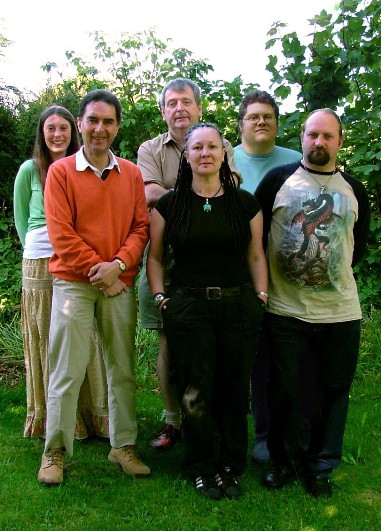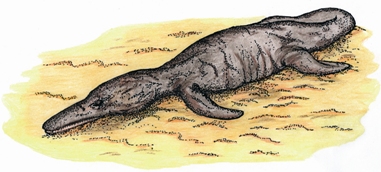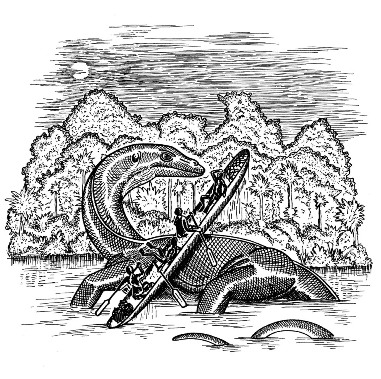British Explorers Seek Ninki-Nanka and Gambo
Posted by: John Kirk on July 6th, 2006
My good friends at the Centre for Fortean Zoology in Devon, England have filed the first report from their expedition to the Gambia in search of two mysterious animals. The report is as follows:

The Centre for Fortean Zoology [CFZ], the world’s largest mystery animal research group, based in rural North Devon announced tonight that they have received the first news bulletin from their expedition in West Africa. The J.T.Downes memorial Gambia Expedition 2006 has three main aims:
· To dig up part of a beach where an amateur naturalist claims to have buried the carcass of a mysterious fifteen foot sea creature
· To get the first filmed witness testimonies of a dragon-like creature, known to the natives as "Ninki Nanka", which has terrorized the tiny African state for generations, and has reportedly killed people as recently as the 1990s
· To get the first photographs and film of Armitage’s Skink (Chalcides armitagei) – a tiny lizard first described in 1922 and only rediscovered in 1989.
Click image for full-size version
Richard Freeman, the Zoological Director of the CFZ writes:
"A little way up Bungalow Beach we came upon a market place where jewellers made silver Ninki-Nankas. Chris Moiser has known about these traditional designs for years, and knew the man who made them. One of the sellers, Baka Samba told us that his late uncle, a hunter, had seen Ninki-Nanka many years ago. He could not describe it well, as his uncle only described it as very big and terrible. It had four legs, a long tail and an awful looking head. He said it had fire in its mouth. This may actually mean that the inside of the creature’s mouth was red, or that it had a red/orange forked tongue that flickered in and out like flame. He said that the creature was very dangerous, and that those who saw it usually died within four or five years of the sighting".
Click image for full-size version
Another local told them of a "lake in Senegal where Ninki-Nanka was supposed to live. The lake was five kilometers long and was about 250 kilometers away. He said he had seen strange lights on the lake at night, and large disturbances in the water during the day. He drew a furrow in the earth and said he had seen drag-marks like these, but around four feet across around the lake".
The expedition will be in the Gambia for the next two weeks, and hopes to come home with conclusive evidence for the existence of these creatures, which Freeman (36) believes are a hitherto undiscovered species of extremely large Monitor Lizard.
Team members are:
· Chris Moiser: Biologist and team leader
· Dr Chris Clark: Engineer
· Lisa Dowley: First aid and security expert
· Richard Freeman: cryptozoologist
· Oll Lewis: Ecologist
· Suzi Marsh: computer expert

As one who has ventured into Africa in serach of cryptids, I wish the team the very best of luck and hope they are dealing well with the deprivations of journeying hundreds of kilometres up a rather dodgy river system.
Let’s hope the lads and lasses have good news in their next report.
About John Kirk
One of the founders of the BCSCC, John Kirk has enjoyed a varied and exciting career path. Both a print and broadcast journalist, John Kirk has in recent years been at the forefront of much of the BCSCC’s expeditions, investigations and publishing. John has been particularly interested in the phenomenon of unknown aquatic cryptids around the world and is the author of In the Domain of the Lake Monsters (Key Porter Books, 1998).
In addition to his interest in freshwater cryptids, John has been keenly interested in investigating the possible existence of sasquatch and other bipedal hominids of the world, and in particular, the Yeren of China. John is also chairman of the Crypto Safari organization, which specializes in sending teams of investigators to remote parts of the world to search for animals as yet unidentified by science. John travelled with a Crypto Safari team to Cameroon and northern Republic of Congo to interview witnesses among the Baka pygmies and Bantu bushmen who have sighted a large unknown animal that bears more than a superficial resemblance to a dinosaur.
Since 1996, John Kirk has been editor and publisher of the BCSCC Quarterly which is the flagship publication of the BCSCC. In demand at conferences, seminars, lectures and on television and radio programs, John has spoken all over North America and has appeared in programs on NBC, ABC, CBS, PBS, TLC, Discovery, CBC, CTV and the BBC.
In his personal life John spends much time studying the histories of Scottish Clans and is himself the president of the Clan Kirk Society. John is also an avid soccer enthusiast and player.












Good luck to the ladies & gents.
While I rather doubt that the creature could be as large as the illustration shows, the idea of a large monitor lizard is certainly not a huge reach.
Safe journey folks.
I would love to see some success from this expedition. I consider myself something of a herpetologist, so anything involving reptiles is automatically top-of-the-list.
Good hunting.
I look forward to the updates.
Basing an expedition on local legend is an enormous waste of time. I guarantee they find absolutely nothing.
all legends begin with something. at least some of the stories are recent. I do hope they find something to bring home. boy what history could be made there.
Sounds like a fantastic adventure. Hope it goes extremely well!!
The “amateur naturalist ” was, of course, 15-year-old Owen Burnham, who discovered the carcass. He and his family buried it on June 12, 1983, on Bungalow Beach, which is used frequently by tourists.
Ole bub…
Wishes the expedition…success, safety and God speed….it’s a jungle out there…
all the best…
ole bub and the dawgs
Mateo I strongly disagree with your comment.
Please understand I am not having’a pop’ at you but to dismiss local legend as an enourmous waste of time comes across as a little conceited.
I always find information from local/first nation peoples very informative-in some situations they still live very closely with their natural environments without outside influences changing their perspective.
I say we should listen and learn not just write it off as lets face it many of these people have actually seen the creatures we spend so much time researching and talking about far away from the environments that they live in.
I very much hope that the team is able to capture a cryptid on film. To some, this is just another expedition. To others, it represents our passion for this field of science which is far too often readily dismissed. We can never know where validation is going to come from, a hunter with a cam, a fisherman who brings up a coelacanth, or hopefully, this team, who has passionately undertaken this quest with the humble yet noble goal of finding something new.
And even if they don’t find something, letting the local peoples know there is interest is important. They live in the environment. They are more likely to see one. If they know folks are looking (and possibly willing to pay a little something), they are more likely to save the skulls/skins/living specimens next time they encounter one.
I hope them luck and safety! Thanks for the update.
Monitor Lizard, in all likelyhood. A tylosaur or Mosasaur would suffocate under its own weight on the beach.